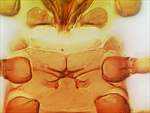
corticosus

gersoni

hypni

tallagandai

taverni

corticosus prosternites

tallagandai

tallagandai prosternites

taverni prosternites

corticosus

hypni

tallagandai

taverni

thomsonae

thomsonae male pore plate
Generic diagnosis
Small, apterous or micropterous (rarely macropterous) Phlaeothripinae with antennal segment III small. Head longer than wide, vertex with little or no sculpture; compound eyes not large; maxillary stylets usually retracted anterior to postocular setae and less than one-third of head width apart. Antennae 8-segmented; segment III smaller than segment IV, without sense cones (rarely with one), segment IV with 2 or 3 sense cones; VIII usually elongate and narrowed to base, but sometimes joined to VII. Pronotum with little sculpture; notopleural sutures usually incomplete; usually with 5 pairs of major setae, anteromarginal pair sometimes small. Prosternal basantra absent or weakly present; ferna large; mesopresternum rarely transverse, usually reduced to two weak triangles; metathoracic sternopleural sutures absent. Metanotum with little or no sculpture. Fore tarsal tooth usually absent in both sexes (rarely present and minute). Pelta weak, broadly D-shaped; wing-retaining setae usually not developed; tergite IX major setae longer than tube. Male similar to female, tergite IX setae S2 shorter than S1; sternite VIII pore plate present or absent.
Nomenclatural data
Lissothrips Hood, 1908: 365. Type species Lissothrips muscorum Hood, 1908, by monotypy.
There are 23 species recognised in this genus (ThripsWiki, 2022).
Australian species
Lissothrips corticosus Mound & Tree, 2015: 363
Lissothrips dentatus Mound & Walker, 1986: 66
Lissothrips discus Mound & Tree, 2015: 367
Lissothrips gersoni Mound & Walker, 1986: 68
Lissothrips hypni Mound & Tree, 2015: 368
Lissothrips tallagandai Mound & Tree, 2015: 369
Lissothrips taverni Mound & Tree, 2015: 369
Lissothrips thomsonae Mound & Tree, 2015: 370
Relationship data
The species in this genus are small with weak sclerotisation and reduced number of antennal sense cones. As a result relationships are difficult to determine, but the genus is probably derived from the Phlaeothrips-lineage in the Phlaeothripinae.
Distribution data
The genus is widespread around the world, but the species seem to exist only in areas with high humidity in which their hosts can thrive.
Biological data
The species of this genus are found on mosses and lichens.
References
Mound LA (1989) Systematics of thrips (Insecta: Thysanoptera) associated with mosses. Zoological Journal of the Linnean Society 96: 1–17.
Mound LA & Tree DJ (2015) The genus Lissothrips from mosses and lichens in Australia and New Zealand (Thysanoptera, Phlaeothripinae) Zootaxa 3946 (3): 361–373.
ThripsWiki (2022) ThripsWiki - providing information on the World's thrips. Available from: http://thrips.info/wiki/ (Accessed 15.iii.2022)